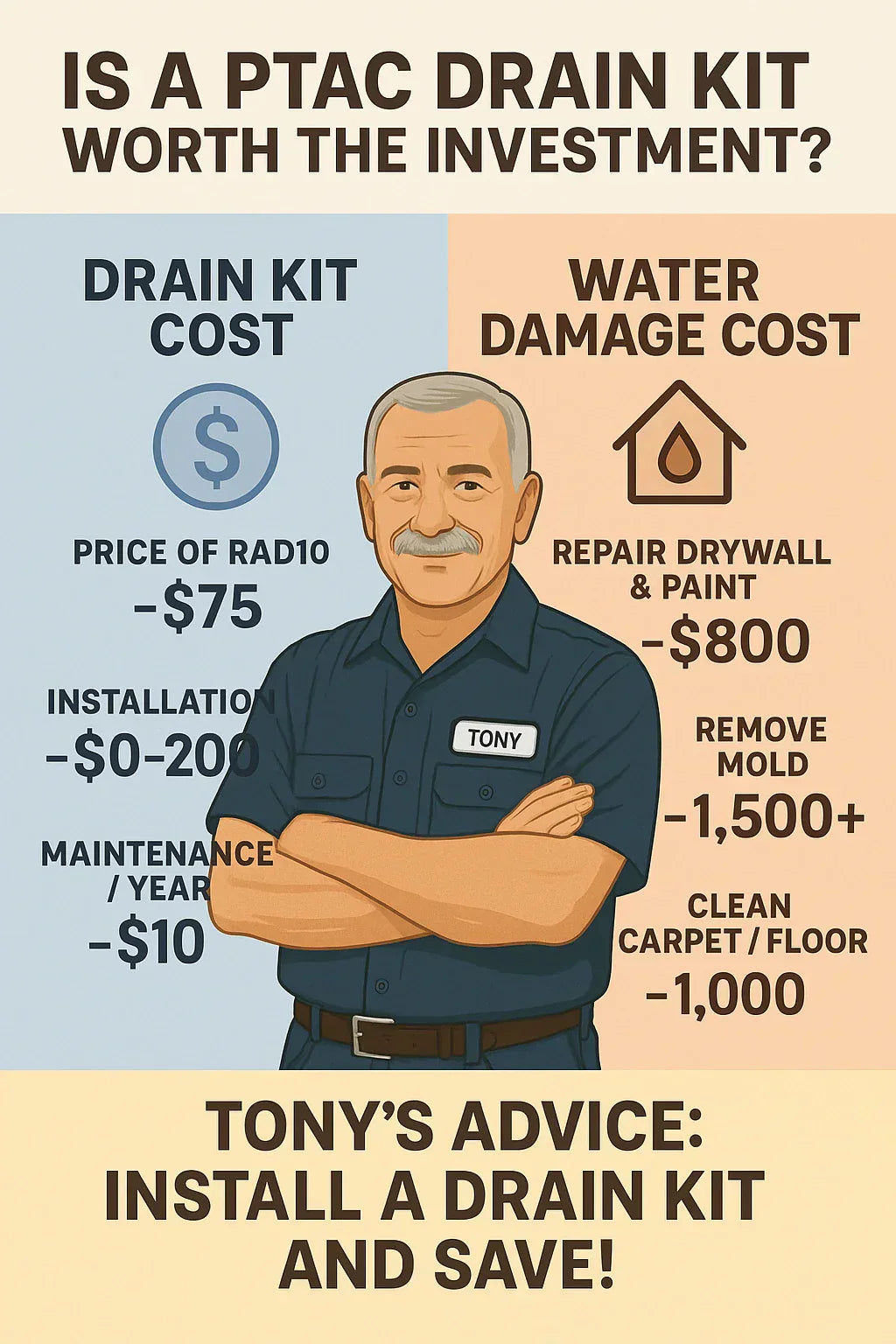Hey folks, Tony here. Let’s talk about something I get asked all the time when I’m installing GE Zoneline PTACs:
“Do I really need a drain kit, or is it just an upsell?”
I get it—when you’re buying a new PTAC, accessories start to feel like add-ons that jack up the bill. Wall sleeves, grilles, thermostats, filters… and now a drain kit? But let me tell you: when it comes to PTAC accessories, the drain kit is in a league of its own.
GE Zoneline PTAC Condensate Internal/External Drain Kit RAD10
I learned the hard way. Years ago, I skipped the drain kit on a small apartment install. Three months later, the tenant called about water stains on the wall and a musty smell. By the time I fixed it, the repair bill was more than 10 times what the kit would’ve cost.
So today, I’m breaking it down for you: the real costs of owning a PTAC without a drain kit versus the small upfront investment of buying one.
💵 Section 1: Upfront Cost of a Drain Kit
The first thing everyone wants to know is: What’s it going to cost me upfront?
🔹 GE RAD10 Drain Kit Price
-
Typically runs between $50–$100 depending on the supplier.
-
Some online retailers include it in bundle deals with the wall sleeve.
👉 PTAC Central lists similar OEM kits in this range and notes they’re required on most new installs.
🔹 Installation Costs
-
DIY install: Free if you’re handy—it takes about 30 minutes.
-
Pro install: $100–$200 for labor if added during setup.
🔹 Comparison to Other Accessories
-
Wall Sleeve: $100–$150 (mandatory for installation).
-
Grille: $40–$75.
-
Filter: $15–$30 (replace regularly).
-
Thermostat Interface: $75–$200.
👉 The drain kit falls on the lower end of the cost spectrum—but delivers outsized protection.
⚠️ Section 2: The Hidden Costs of Skipping a Drain Kit
Now here’s where things get real. Not installing a drain kit doesn’t just mean you “save” $75. It means you’re gambling with potentially thousands in hidden costs.
🔹 Water Damage Repair
-
Leaks can stain drywall, bubble paint, and rot framing.
-
Repair costs: $500–$2,500 depending on severity.
🔹 Mold Remediation
-
Standing water breeds mold.
-
Remediation costs: $1,000–$5,000+ depending on spread.
-
Mold also impacts health—something no family or tenant wants.
👉 EPA notes that even small mold patches can spread fast if moisture isn’t controlled.
🔹 Flooring & Carpet Replacement
-
Water pooling near the PTAC can ruin flooring.
-
Repair costs: $500–$2,000 for hardwood or carpet replacement.
🔹 Customer Complaints & Liability (Hotels/Apartments)
-
Leaks in multi-unit buildings mean unhappy tenants or guests.
-
Negative reviews can cost thousands in lost bookings.
🔹 Reduced PTAC Lifespan
-
Standing water corrodes parts and stresses the compressor.
-
Early replacement cost: $800–$1,500 per unit.
💧 Section 3: Long-Term Value of the RAD10
Now let’s flip it. What does that $75 investment actually buy you over the years?
🔹 Protects Your Walls & Floors
-
Prevents stains, rot, and costly repairs.
🔹 Prevents Mold Growth
-
By keeping water moving, you cut off the #1 ingredient mold needs: moisture.
🔹 Extends PTAC Lifespan
-
Keeps condensate away from sensitive parts.
-
Units can last years longer when kept dry.
🔹 Fewer Service Calls
-
Saves $100–$200 every time you avoid a “PTAC leaking” call.
👉 The Furnace Outlet notes that drainage issues are the #1 source of callbacks—something hotels especially want to avoid.
🧰 Section 4: Maintenance Costs & Effort
A big part of this cost question is ongoing upkeep. The good news? Drain kits are nearly maintenance-free.
🔹 Maintenance Steps
-
Flush with vinegar + warm water every 3–6 months.
-
Vacuum or brush line if clogged.
-
Inspect gasket once a year.
🔹 Cost
-
Vinegar: $3 a jug.
-
Shop vac (if you don’t already own one): $75–$100, but reusable for countless jobs.
-
Replacement gasket (rarely needed): $5–$10.
👉 Quality Home Air Care recommends vinegar flushes twice a year to keep drains clear of algae.
Tony’s Tip: Ten minutes with a jug of vinegar saves me hundreds in repair bills.
📖 Section 5: Case Study – Tony’s Experience
Let me give you two real-world stories from my own installs.
🔹 Case 1: Skipping the Kit
-
Installed a Zoneline in a rental apartment.
-
Tenant called three months later: water stains, musty smell.
-
Drywall replacement + repaint: $1,200.
-
Mold treatment: $800.
-
My profit on the job? Gone.
🔹 Case 2: Installing the RAD10
-
Installed a Zoneline in a senior living facility with the RAD10.
-
Zero leaks for five years.
-
Simple seasonal flush kept everything running smooth.
-
Manager told me it was the best $75 they ever spent.
Tony’s Take: The RAD10 paid for itself the very first time it stopped a drip.
🧮 Section 6: Cost vs. Risk Calculator
Let’s put it in numbers:
With Drain Kit
-
Upfront: $75
-
Maintenance: $10/year
-
Risk of major repair: Near zero
Without Drain Kit
-
Upfront: $0
-
Maintenance: None
-
Risk of repair: $500–$5,000+
👉 Over a 10-year lifespan, you’re spending maybe $175 with the kit vs. risking $5,000+ without it.
That’s not an upsell—that’s common sense.
✅ Section 7: Wrap-Up – Is It Worth It?
So, is a PTAC drain kit worth the investment?
-
For homeowners: Yes. It prevents mold, protects your home, and extends your PTAC’s life.
-
For property managers: Absolutely. It reduces complaints, callbacks, and costly repairs across multiple units.
-
For DIYers: 100%. It’s an easy install and the cheapest insurance you can buy.
Tony’s Bottom Line: The RAD10 isn’t an accessory—it’s a necessity.
In the next topic we will know more about: Can You DIY a PTAC Drain Kit Install or Should You Call a Pro?







